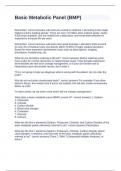Basic Metabolic Panel (BMP)
Remember correct answers Lab tests are central to medicine. Lab testing is the single
highest-volume medical activity. There are over 7.8 million tests ordered yearly, nearly
4,000 tests available, 500 are ordered on a daily basis, and world-wide utilization is
expected to increase 8% per year!
Remember correct answers Lab tests exert great leverage. Laboratory tests account
for only 4% of medical costs, but directly affect 70-80% of major medical decisions.
Bases for more expensive downstream costs such as prescriptions. imaging,
procedures, hospital stay, etc.
What do you do before ordering a lab test? correct answers Before ordering a test,
have a plan for normal, abnormal, or indeterminate result. If this thought experiment
demonstrates the test won't change management, or if your don't know how to
interpret/act upon all possible results, don't order it.
*If it is not going to help you diagnose what is wrong with the patient, do not order the
test!!!*
Why do you not order unnecessary tests? correct answers For example: If you draw
blood in house, this wastes time if test is not needed; this will also create unnecessary
follow up visits.
*In other words, do not order a test which will not change management*
What does a basic metabolic panel (BMP) consist of? correct answers 1. Sodium
2. Potassium
3. Chloride
4. Carbon dioxide
5. Blood urea nitrogen
6. Creatinine
7. Glucose
8. Calcium
What are the first 4 elements (Sodium, Potassium, Chloride, and Carbon Dioxide) of the
basic metabolic panel collectively referred to as? correct answers Electrolytes
What are the first 7 elements (Sodium, Potassium, Chloride, Carbon Dioxide, Blood
Urea Nitrogen, Creatinine, and Glucose) of the basic metabolic panel collectively
referred to as? correct answers Chem 7, SMA 7 (Sequential Multiple Analyzer), or
Astra 7
,*They were called this because the machine they are run on does them all at the same
time*
What element of the basic metabolic panel was just added several years ago? correct
answers Calcium, and then collectively called all the tests a basic metabolic panel
(BMP)
What does a comprehensive metabolic panel (CMP) include? correct answers It adds
Albumin and liver function tests (LFT's)
*AST/ALT* <--liver enzymes
When collecting a BMP specimen, what is the amount of blood taken? correct answers
A full tube is required
When collecting a BMP specimen, what is the proper tube for the blood taken? correct
answers Tiger top, red top or gold topped
How often is a BMP specimen collected? correct answers As often as you need
Under what circumstances is a BMP needed? correct answers When a patient is
dehydrated, taking diuretics, potassium, checking glucose, evaluating kidney function,
etc.
What is the Fishbone notation of a BMP or Chem 7 as it is often referred to as? correct
answers KNOW HOW TO DRAW THIS AND WHAT VALUES ARE WHERE (slide 12 in
BMP notes)
What are the electrolytes in the BMP? correct answers 1. Sodium (Na)
2. Potassium (K)
3. Chloride (Cl)
4. Carbon dioxide (bicarbonate) (CO2)
What are electrolytes exactly? correct answers Electrolytes are minerals in your blood
and other body fluids that either carry a positive charge (cation), or a negative charge
(anion). They are taken in as chemical compounds that dissociate into ions within the
body. Helps balance pH and acid-base levels in the body. Facilitate fluid movement into
and out of cells. Aids in regulation of endocrine system. Vital for nerve impulse
transmission and muscle contraction.
What are the main electrolytes in body fluid and what are their charges? correct
answers 1. Sodium (Na+)
2. Calcium (Ca2+)
3. Potassium (K+)
4. Chloride (Cl-)
, 5. Magnesium (Mg2+)
*Each ion has its own rules, and body movement is a result of the function of these
ions*
What is sodium, what is it used to evaluate, and what is its major role in the BMP?
correct answers Sodium is an electrolyte and it is the main extracellular cation.
Sodium is used to evaluate and monitor fluid and electrolytes. *Physiologically, sodium
and water are closely related aka wherever sodium goes, water will follow* Sodium
reflects serum osmolality and changes in free water balance.
The major role of sodium is:
1) water balance between blood and body tissue cells (fluid volume)
2) transmitting nerve impulses (excitability)
3) the acid-base equilibrium
*Most common electrolyte abnormality in hospitalized patients*
What is sodium excreted by in the body? correct answers The kidneys
What is the sodium content in blood a balance between? correct answers It is a
balance between dietary sodium intake and renal excretion
What are some of the chemicals that alter the sodium in blood? correct answers 1)
Aldosterone
2) Antidiuretic Hormone
3) Renin Angiotensin System
What are the normal values of sodium in the BMP? correct answers 136-145 mEq/L
What are the critical values of sodium in the BMP? correct answers <120 mEq/L
>160 mEq/L
What is hypernatremia? correct answers Too much sodium aka too much of a positive
(+) charge.
Na >145 mEq/L
It is a hyperosmolar condition caused by decrease in total body water (TBW) relative to
electrolyte content.
*Hypernatremia = "water problem," NOT a problem of sodium homeostasis*
This is generally caused by a change in thirst response or behavioral response to thirst
(elderly, psych patients).




